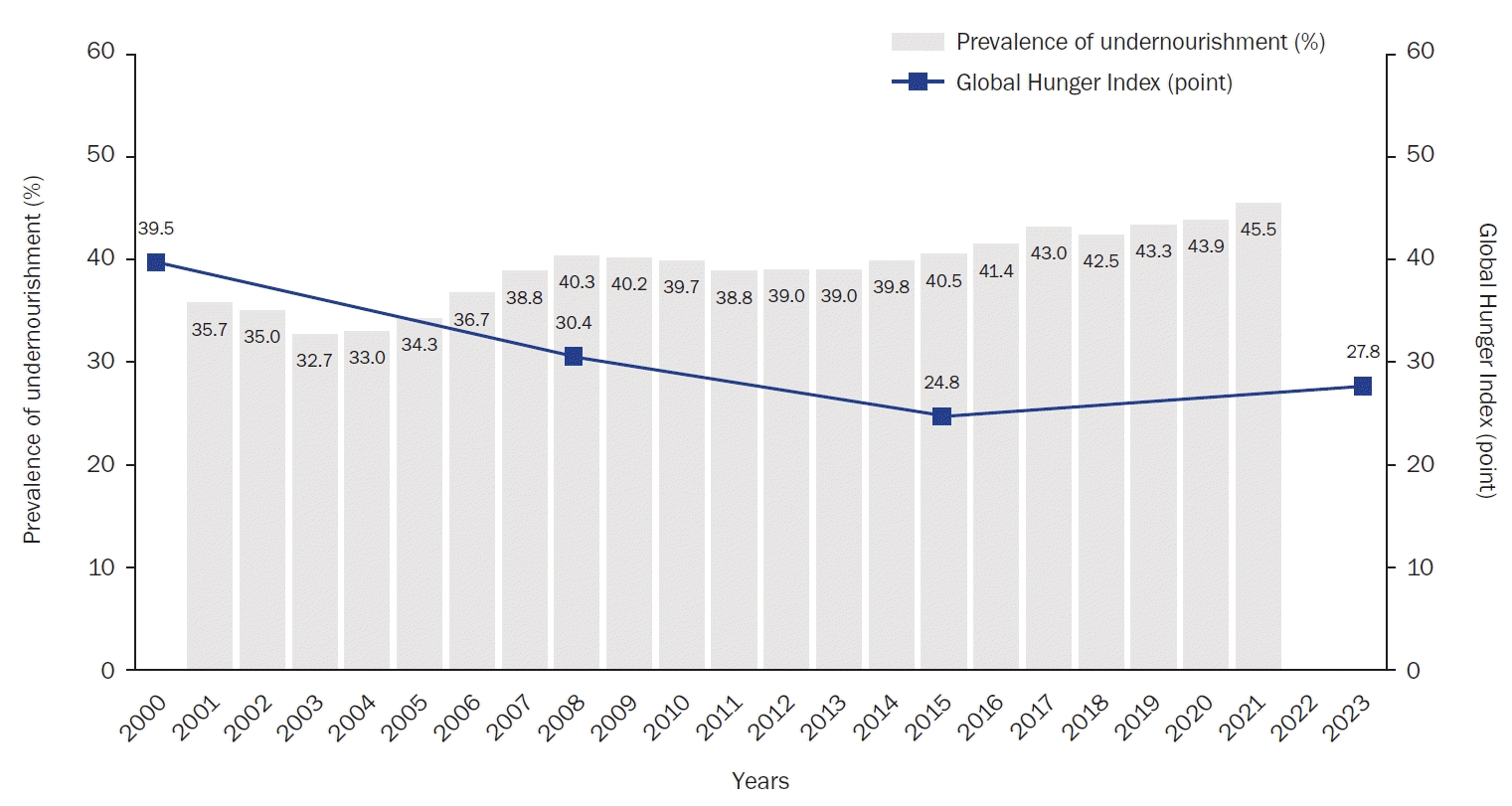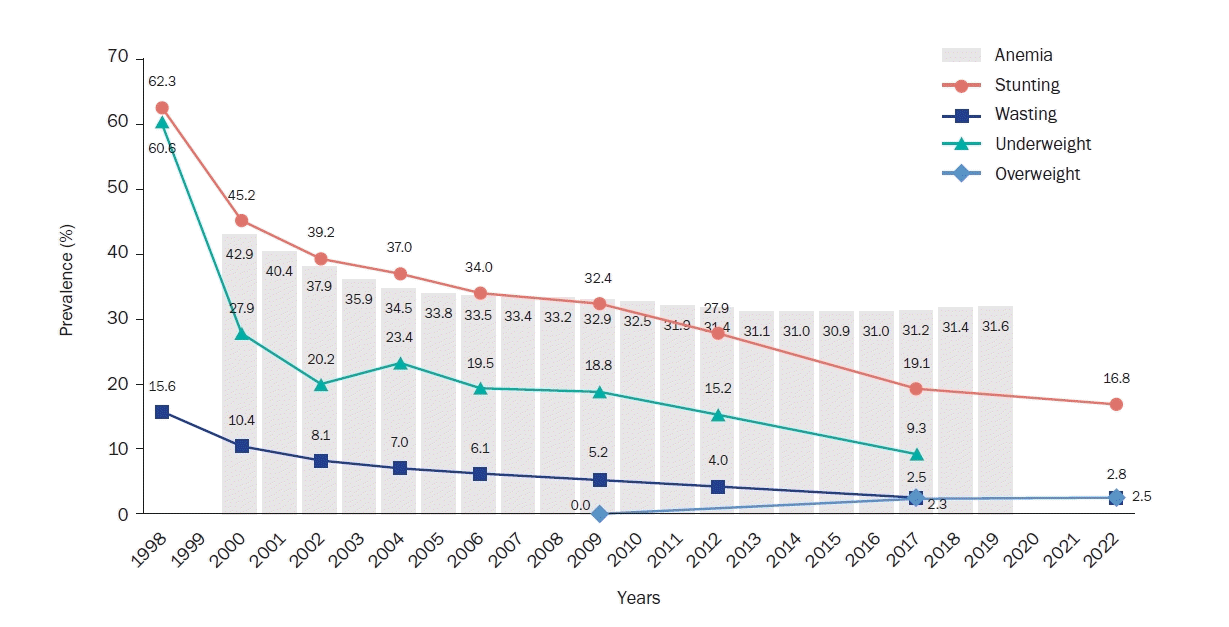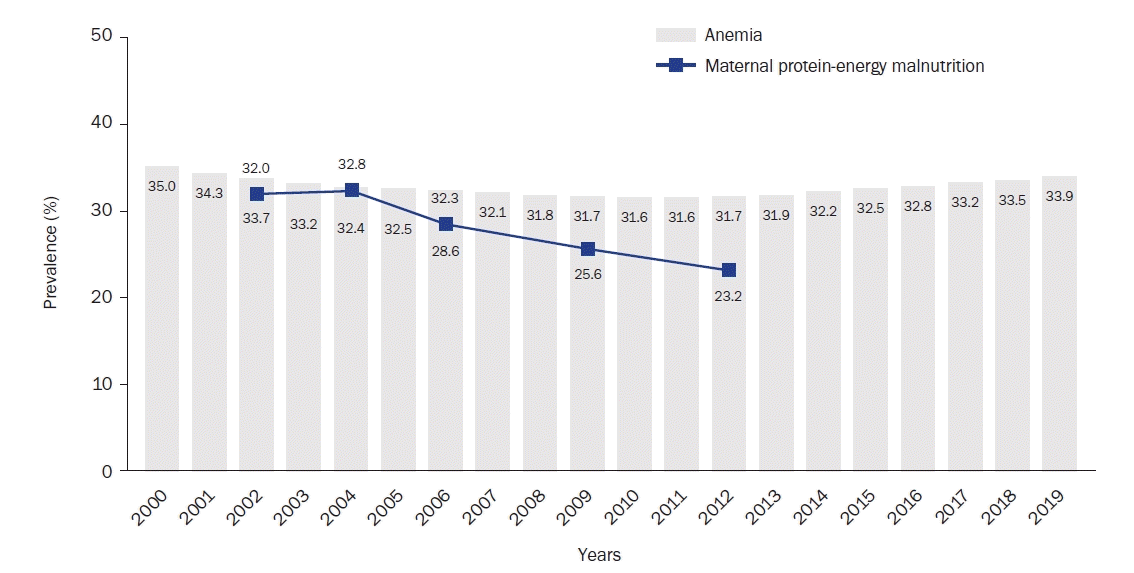Abstract
Objectives
Methods
Results
Conclusions
Notes
Conflict of Interest
There are no financial or other issues that might lead to conflict of interest.
REFERENCES
Fig. 1.

Fig. 2.

Fig. 3.

Table 1.
| Nutritional indicators | North Korea | South Korea | Low-income country average1) | World average |
|---|---|---|---|---|
| General population | ||||
| Prevalence of undernourishment | 45.5 (2020–2022)5) | < 2.5 (2020–2022)5) | 28.1 (2020–2022)5) | 9.2 (2020–2022)5) |
| Prevalence of food insecurity2) | 40.0 (2019)6) | 5.1 (2018–2020)5) | 60.4 (2018–2020)5) | 26.6 (2018–2020)5) |
| Prevalence of households with poor food consumption | 69.6 (2021)7) | - | - | - |
| Global hunger index3) | 27.8 (2023)8) | - | - | 18.3 (2023)8) |
| Children under 5 years | ||||
| Prevalence of stunting | 16.8 (2022)5) | 1.7 (2022)5) | 33.5 (2022)9) | 22.3 (2022)5) |
| Prevalence of wasting | 2.5 (2022)5) | 0.2 (2022)5) | 6.6 (2022)9) | 6.8 (2022)5) |
| Prevalence of underweight | 9.3 (2017)10) | 0.9 (2017)11) | 20.0 (2017)11) | 13.5 (2017)11) |
| Prevalence of overweight | 2.8 (2022)5) | 5.4 (2022)5) | 3.4 (2022)9) | 5.6 (2022)5) |
| Prevalence of anemia4) | 31.6 (2019)11) | 15.0 (2019)11) | 58.9 (2019)11) | 39.8 (2019)11) |
| Reproductive-aged women (15–49 years) | ||||
| Prevalence of anemia | 33.9 (2019)5) | 13.5 (2019)5) | 38.8 (2019)5) | 29.9 (2019)5) |
| Prevalence of protein-energy malnutrition | 23.2 (2012)12) | - | - | - |
1) For the current 2024 fiscal year, low-income economies are defined as those with a gross national income (GNI) per capita, calculated using the World Bank Atlas method, of $1,135 or less in 2022 by the World Bank.
2) In the case of South Korea, low-income countries, and the world, the prevalence of food insecurity is the prevalence of moderate or severe food insecurity in the total population.
3) 100-point scale: a value of 100 signifies that a country’s undernourishment, child wasting, child stunting, and child mortality levels each exactly meet the thresholds set slightly above the highest levels observed worldwide in recent decades. For the 2023 Global Hunger Index, data were assessed for 125 countries.
5) Data from Food and Agriculture Organization of the United Nations (http://www.fao.org/faostat) [2].
6) Data from Food and Agriculture Organization of the United Nations and World Food Programme (https://www.wfp.org/publications/democratic-peoples-republic-korea-dprk-faowfp-joint-rapid-food-security-assessment) [4].
7) Data from World Food Programme (https://uploads.mwp.mprod.getusinfo.com/uploads/sites/67/2022/03/3.-WFPs-Update-on-Food-and-Nutrition-Security-Situation-in-DPR-Korea-by-Mr.-Aylieff.pdf) [17].
8) Data from Welthungerhilfe and Concern Worldwide (https://www.globalhungerindex.org/pdf/en/2023.pdf) [3].
9) Data from Food and Agriculture Organization of the United Nations et al. (https://docs.wfp.org/api/documents/WFP-0000151116/download/?_ga=2.107116868.71777565.1724027384-299261806.1724027384) [6].
10) Data from Central Bureau of Statistics of the DPR Korea and United Nations Children’s Emergency Fund (https://www.unicef.org/dprk/media/156/file/MICS.pdf) [22].
11) Data from World Bank Group (https://data.worldbank.org/) [5].
12) Data from United Nations Children’s Fund et al. (https://www.ncnk.org/sites/default/files/content/resources/publications/DPRK_NNS%20Final%20Report_%202013.pdf) [23].
Table 2.
| Characteristic | South Korean adults 1) |
Respondent |
P-value2) | ||
|---|---|---|---|---|---|
| Total (n = 1,000) | 20s–40s (n = 617) | 50s–60s (n = 383) | |||
| Gender | 0.643 | ||||
| Men | 49.9 | 508 (50.8) | 317 (51.4) | 191 (49.9) | |
| Women | 50.1 | 492 (49.2) | 300 (48.6) | 192 (50.1) | |
| Age (year) | < 0.001 | ||||
| 19–29 | 18.3 | 196 (19.6) | 196 (31.8) | 0 (0.0) | |
| 30–39 | 19.0 | 194 (19.4) | 194 (31.4) | 0 (0.0) | |
| 40–49 | 22.5 | 227 (22.7) | 227 (36.8) | 0 (0.0) | |
| 50–59 | 23.3 | 228 (22.8) | 0 (0.0) | 228 (59.5) | |
| 60–69 | 16.9 | 155 (15.5) | 0 (0.0) | 155 (40.5) | |
| Region with the longest residency before age 15 | 0.379 | ||||
| Seoul & metropolitan area | 50.0 | 517 (51.7) | 333 (54.0) | 184 (48.0) | |
| Yeongnam | 25.1 | 257 (25.7) | 150 (24.3) | 107 (27.9) | |
| Chungcheong | 11.2 | 100 (10.0) | 61 (9.9) | 39 (10.2) | |
| Honam | 10.7 | 97 (9.7) | 58 (9.4) | 39 (10.2) | |
| Gangwon | 3.0 | 29 (2.9) | 15 (2.4) | 14 (3.7) | |
| Political orientation | 0.002 | ||||
| Conservative | - | 229 (22.9) | 119 (19.3) | 110 (28.7) | |
| Moderate | - | 431 (43.1) | 282 (45.7) | 149 (38.9) | |
| Progressive | - | 340 (34.0) | 216 (35.0) | 124 (32.3) | |
1) Data from Ministry of the Interior and Safety (https://jumin.mois.go.kr) [32].
Table 3.
| Item | Total (n = 1,000) | 20s–40s (n = 617) | 50s–60s (n = 383) | P-value1) |
|---|---|---|---|---|
| Prevalence of undernourishment | 0.003 | |||
| < 5% | 13 (1.3) | 7 (1.1) | 6 (1.6) | |
| ≥ 5% and < 15% | 45 (4.5) | 28 (4.5) | 17 (4.4) | |
| ≥ 15% and < 25% | 73 (7.3) | 38 (6.2) | 35 (9.1) | |
| ≥ 25% and < 35% | 176 (17.6) | 90 (14.6) | 86 (22.5) | |
| ≥ 35% [47.6%]2),3) | 693 (69.3) | 454 (73.6) | 239 (62.4) | |
| Prevalence of food insecurity | 0.003 | |||
| < 20% | 38 (3.8) | 20 (3.2) | 18 (4.7) | |
| ≥ 20% and < 40% | 176 (17.6) | 93 (15.1) | 83 (21.7) | |
| ≥ 40% and < 60% [40%]2),4) | 269 (26.9) | 156 (25.3) | 113 (29.5) | |
| ≥ 60% and < 80% | 314 (31.4) | 207 (33.5) | 107 (27.9) | |
| ≥ 80% | 203 (20.3) | 141 (22.9) | 62 (16.2) | |
| Prevalence of stunting (in children under 5 years) | < 0.001 | |||
| < 20% [19.1%]2),5) | 44 (4.4) | 24 (3.9) | 20 (5.2) | |
| ≥ 20% and < 30% | 163 (16.3) | 95 (15.4) | 68 (17.8) | |
| ≥ 30% and < 40% | 256 (25.6) | 134 (21.7) | 122 (31.9) | |
| ≥ 40% | 537 (53.7) | 364 (59.0) | 173 (45.2) | |
| Prevalence of wasting (in children under 5 years) | 0.113 | |||
| < 5% [2.5%]2),5) | 21 (2.1) | 12 (1.9) | 9 (2.3) | |
| ≥ 5% and < 10% | 83 (8.3) | 50 (8.1) | 33 (8.6) | |
| ≥ 10% and < 15% | 179 (17.9) | 97 (15.7) | 82 (21.4) | |
| ≥ 15% | 717 (71.7) | 458 (74.2) | 259 (67.6) |
2) Correct answers. Numbers in square brackets represent the reported values of each nutritional indicator.
3) Data from Food and Agriculture Organization of the United Nations (http://www.fao.org/faostat) [2].
4) Data from Food and Agriculture Organization of the United Nations and World Food Programme (https://www.wfp.org/publications/democratic-peoples-republic-korea-dprk-faowfp-joint-rapid-food-security-assessment) [4].
5) Data from Central Bureau of Statistics of the DPR Korea and United Nations Children’s Emergency Fund (https://www.unicef.org/dprk/media/156/file/MICS.pdf) [22].
Table 4.
| Item | Total (n = 1,000) | 20s–40s (n = 617) | 50s–60s (n = 383) | P-value1) |
|---|---|---|---|---|
| Hunger level2) in North Korea | 0.009 | |||
| Low (< 10) | 27 (2.7) | 11 (1.8) | 16 (4.2) | |
| Moderate (≥ 10 and < 20) | 101 (10.1) | 61 (9.9) | 40 (10.4) | |
| Serious (≥ 20 and < 35) [27.7]3) | 318 (31.8) | 179 (29.0) | 139 (36.3) | |
| Alarming (≥ 35 and < 50) | 327 (32.7) | 214 (34.7) | 113 (29.5) | |
| Extremely alarming (≥ 50) | 227 (22.7) | 152 (24.6) | 75 (19.6) | |
| Comparison of hunger level2) | ||||
| North Korea vs. China | 0.016 | |||
| North Korea is more severe3) | 880 (88.0) | 529 (85.7) | 351 (91.6) | |
| China is more severe | 35 (3.5) | 24 (3.9) | 11 (2.9) | |
| Both are similar | 85 (8.5) | 64 (10.4) | 21 (5.5) | |
| North Korea vs. Philippines | 0.644 | |||
| North Korea is more severe3) | 813 (81.3) | 496 (80.4) | 317 (82.8) | |
| Philippines is more severe | 48 (4.8) | 31 (5.0) | 17 (4.4) | |
| Both are similar | 139 (13.9) | 90 (14.6) | 49 (12.8) | |
| North Korea vs. Afghanistan | 0.439 | |||
| North Korea is more severe | 177 (17.7) | 103 (16.7) | 74 (19.3) | |
| Afghanistan is more severe3) | 421 (42.1) | 268 (43.4) | 153 (39.9) | |
| Both are similar | 402 (40.2) | 246 (39.9) | 156 (40.7) | |
| A past period in South Korea with hunger levels similar to present-day North Korea | 0.163 | |||
| Before 1950s | 157 (15.7) | 95 (15.4) | 62 (16.2) | |
| 1960s3) | 456 (45.6) | 272 (44.1) | 184 (48.0) | |
| 1970s | 285 (28.5) | 176 (28.5) | 109 (28.5) | |
| 1980s | 73 (7.3) | 50 (8.1) | 23 (6.0) | |
| 1990s | 21 (2.1) | 17 (2.8) | 4 (1.0) | |
| After 2000s | 8 (0.8) | 7 (1.1) | 1 (0.3) |
2) The question included the description of the Global Hunger Index (GHI) and the GHI severity scale.
3) Correct answers. Numbers in square brackets represent the Global Hunger Index. Data from Welthungerhilfe and Concern Worldwide (https://www.globalhungerindex.org/pdf/en/2019.pdf) [33].
Table 5.
| Item | Total (n = 1,000) | 20s–40s (n = 617) | 50s–60s (n = 383) | P-value1) |
|---|---|---|---|---|
| Concern about food shortages and malnutrition in North Korea | ||||
| I am generally concerned about food shortages in North Korea | 2.87 ± 0.91 | 2.75 ± 0.92 | 3.08 ± 0.84 | < 0.001 |
| I am generally concerned about malnutrition in North Korea | 2.85 ± 0.95 | 2.73 ± 0.97 | 3.05 ± 0.90 | < 0.001 |
| Severity of food shortages and malnutrition in North Korea | ||||
| Food shortages in North Korea are so severe that the country requires food aid from other nations | 3.63 ± 0.95 | 3.58 ± 0.96 | 3.71 ± 0.93 | 0.042 |
| Malnutrition in North Korea is so severe that the country requires food aid from other nations | 3.67 ± 0.94 | 3.63 ± 0.97 | 3.75 ± 0.87 | 0.045 |




 PDF
PDF Citation
Citation Print
Print



 XML Download
XML Download